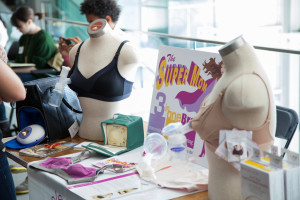When You Exclusively Pump
Every family wants to provide the best for their baby, but the “best” can look different for different families. No matter what feeding method you choose for your newborn, there are ways to make it a good experience for everyone.
If you decide that exclusive pumping is the preferred method of feeding your baby, there are plenty of ways to make it a wonderful experience. Here are our top ten tips for exclusive pumpers!
Buy a Good Pump:
For most women, a manual pump isn’t going to be enough. A good quality, double electric pump will help you to pump the most amount of milk in the shortest amount of time. Medela pumps are popular but not your only option. Check with your insurance to see if they cover a pump. A closed system, or hospital grade, pump is a wonderful choice that can mean less cleaning. It is also a good idea to choose a pump with a letdown feature, which can shorten your pumping time as it mimics an infants feeding pattern.
Size Matters:
Make sure your flanges are the right size! Not only can improperly sized flanges hurt your nipples, they can impact your milk supply. If your flanges are the right size, you will be more comfortable and produce more milk.
Keep Hydrated:
Pumping is similar to breastfeeding. If you are dehydrated, your milk production will slow down. In turn, it will take you longer to produce your usual amount of milk and that can cause nipple irritation. A good rule of thumb is to drink an 8oz glass of water every time you pump.
Practice:
Don’t wait until the day before you go back to work or have to be gone all day to break out your pump. The last thing you want to do is be fumbling around with an unfamiliar pump the night before you have to get up early. Test it out and make sure everything works and that you know how to set it up. You should also practice pumping a few times a day to both build up a freezer stash of milk, and to get your body used to the pump. If you are exclusively pumping from the very beginning, understand that it may take a few days or even a few weeks for your body to respond fully to a pump.
Hands Free Bra:
Having to hold two flanges for the entire time you pump, when you are pumping several times a day can be extremely frustrating. It makes it impossible to answer the phone, check your email, soothe the baby, or entertain any older children. A good hands free bra will be a huge benefit to you and will improve your pumping experience. The bra should fit fairly snug as you do not want the weight of the bottle to pull it down.
Compressions:
Even when using a hands free bra, it is important to remember to do breast compressions. Most pumps are designed to pump the front of your breast, which can cause blocked ducts further back, closer to the ribcage. By doing compressions during at least a few of your pumping sessions, you can help prevent blocked ducts from developing. This can also help you drain the breast more completely, which will help to increase your milk supply and making pumping sessions more productive.
Clean Up:
You do not need to sterilize your pump parts after every pumping session unless indicated by your child’s doctor. It is fine to sterilize once a day, when you go to bed. During the day, you can even put your bottle and flange in the fridge if you are going to mix the milk from each pumping session.
Know Your Pump:
The let down feature on most electric pumps can make a wonderful difference in pumping. This setting mimics the short, rapid sucks that a baby does when they first latch, creating a let down. You can even turn this setting on multiple times during a pumping session, in order to cause multiple let downs. This will increase your milk output and even allow you to store extra milk for days when you are not home to pump.
Pump on a Schedule:
It is best, especially in the early days, to pump on a similar schedule to when baby eats. This means every 2-4 hours, including through the night. Your milk supply is not fully established until approximately four months postpartum. If you skip multiple pumping sessions during that period, you may not produce as much breast milk.
Take Advantage:
Exclusively pumping means that you can give your baby and a bottle to someone else and slip out of the house for a few hours. Whether you are exclusively pumping in order to return to work, for preference, or for other reasons, being able to leave and not worry about returning in time for your child’s next feeding is a fantastic perk. Enjoy it…just don’t forget to take your pump with you!

